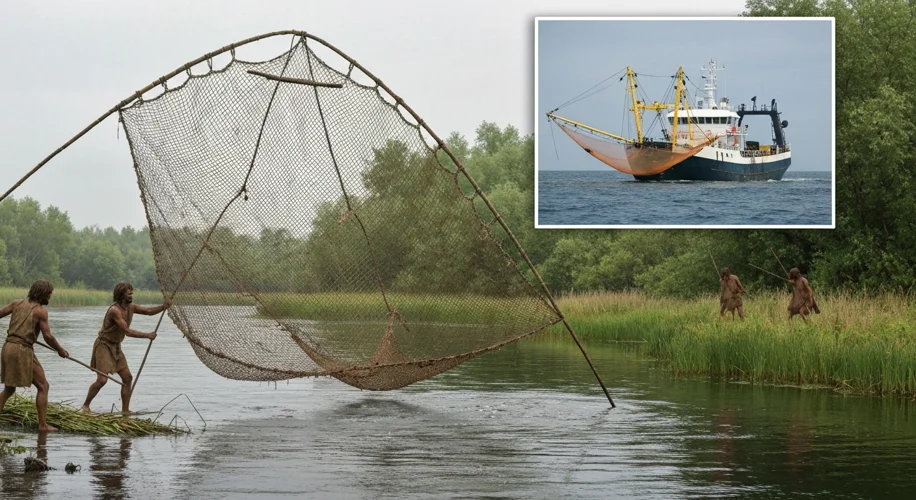The Web That Fed the World: A History of Fishing Nets
Imagine a time before supermarkets, before refrigeration, before bustling ports humming with modern trawlers. For our ancient ancestors, survival depended on a deep, often perilous, relationship with the natural world. And when it came to securing sustenance from the vast, life-giving waters, one simple, ingenious invention stood tall: the fishing net.

Threads of Survival: Early Beginnings
The story of fishing nets is as old as humanity’s need to eat. Long before written records, our forebears understood the power of a simple woven structure to outsmart their slippery prey. The earliest nets weren’t made of nylon or polyethylene, but of natural materials readily available in their environment. Think of the tough, fibrous reeds pulled from riverbanks, the sinews of hunted animals carefully prepared and twisted into cord, or even strands of long grass painstakingly woven together. These weren’t just tools; they were testaments to keen observation and the innate human drive to innovate.
Archaeological whispers and early ethnographic studies suggest net-making and fishing with nets date back at least 20,000 years. Imagine a Paleolithic hunter-gatherer, perhaps by the banks of a mighty river or along a sheltered coastline, meticulously knotting fibers. They weren’t just creating a net; they were weaving a lifeline. The design would have been rudimentary, likely a simple bag or spread net, but effective enough to provide a crucial source of protein. This humble technology allowed early human communities to settle and thrive, moving beyond a purely terrestrial existence.
A Cultural Tapestry: Nets in Ancient Societies
As human societies grew more complex, so too did their fishing technologies. The net evolved, becoming more sophisticated in its design and materials. In ancient Egypt, where the Nile River was the lifeblood of civilization, fishing was not just a means of survival but a significant cultural and economic activity. Elaborate nets, woven from flax or papyrus, were used not only for catching fish for food but also for birds, which formed an important part of the diet.

These nets were often depicted in tomb paintings and hieroglyphs, showcasing their integral role in daily life and religious practices. The skill of net-making was passed down through generations, a vital piece of cultural knowledge. Similarly, in ancient Greece and Rome, fishing was a common practice, and nets of various types were employed. Homer, in his epic poems, even alludes to the use of nets in fishing. The Romans, known for their engineering prowess, developed different net types for various fishing methods, including seine nets, cast nets, and drift nets, highlighting a growing understanding of marine environments and fish behavior.
The Material Revolution: From Natural Fibers to Modern Marvels
For millennia, the primary challenge for net makers was the durability and availability of materials. Natural fibers, while useful, were susceptible to rot and degradation, especially in saltwater. The true revolution in fishing net technology began with the advent of synthetic materials.
The development of nylon in the early 20th century was a game-changer. Suddenly, nets could be made stronger, more flexible, and significantly more resistant to wear and tear. This not only improved fishing efficiency but also opened up possibilities for larger-scale, commercial fishing operations. Later, materials like polyester and polyethylene further enhanced the performance and longevity of fishing nets.
These advancements led to the development of highly specialized nets, each designed for a specific purpose and environment. Think of the massive trawl nets, capable of scooping up vast quantities of fish from the ocean floor, or the fine-mesh gillnets that selectively capture fish by their gills, or even the intricate purse seines that can encircle entire schools of fish. Each type represents a pinnacle of human ingenuity, tailored to the behavior of specific species and the contours of the underwater world.
Economic Engines and Ecological Concerns
The impact of advanced fishing net technology on economies has been immense. Large-scale commercial fishing, powered by efficient nets, has become a cornerstone of global food supply chains, providing livelihoods for millions and a vital source of protein for billions. Fishing ports have grown into bustling hubs of activity, and the trade in seafood has become a global industry.
However, this efficiency has not come without a cost. The very nets that have sustained human populations have also raised serious ecological concerns. Overfishing, driven by the ability to catch fish at unprecedented rates, has depleted fish stocks worldwide. Furthermore, discarded or lost fishing gear, often referred to as “ghost nets,” continues to pose a significant threat to marine life, entangling and drowning countless animals.
Today, the world of fishing nets is at a crossroads. While innovation continues to push the boundaries of efficiency, there is a growing awareness and a concerted effort towards developing more sustainable fishing practices. This includes the design of nets that are more selective, reducing bycatch (the unintended capture of non-target species), and the development of biodegradable materials to mitigate the impact of lost gear. The humble fishing net, which once simply represented a means of survival, now embodies the complex interplay between human ingenuity, economic necessity, and the urgent need for environmental stewardship.
From the woven reeds of our ancient ancestors to the advanced synthetics of modern fleets, the fishing net has been an unwavering companion on humanity’s journey, a testament to our ability to adapt, innovate, and harness the power of the natural world. Its story is, in many ways, the story of us.

